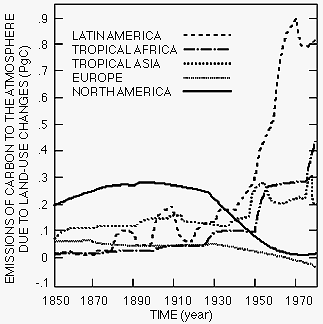


The annual net flux of carbon from land-use changes on the major
continents: Forest degradation and clearing cause much of the carbon loss in South and
Southeast Asia.

How can the uncertainty be reduced in estimates of the contribution of land-use change to atmospheric CO2? What factors are responsible for land-use changes in South and Southeast Asia?

Research efforts over the past 12 years have reduced the uncertainty in carbon emissions due to land-use change from 2 to 22 Pg C/year to 0.4 to 2.6 Pg C/year. Forest degradation, as well as forest clearing, is responsible for much of the carbon loss in South and Southeast Asia.
South America and Africa contribute 650% more than South and Southeast Asia to atmospheric CO2 concentrations due to land-use change.

Dale, V. H., R. A. Houghton, and C. A. S. Hall. 1991. Estimating the effects of land-use change on global atmospheric CO2 concentrations. Canadian Journal of Forest Research 21:87-90.
Integrated Assessment Briefs. 1995. ORNL/M-4227. Oak Ridge National Laboratory, Oak Ridge, TN.